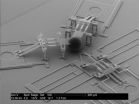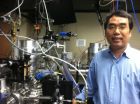(Press-News.org) Researchers from The University of Texas at Dallas and the University of Tokyo have created electronic devices that become soft when implanted inside the body and can deploy to grip 3-D objects, such as large tissues, nerves and blood vessels.
These biologically adaptive, flexible transistors might one day help doctors learn more about what is happening inside the body, and stimulate the body for treatments.
The research, available online and in an upcoming print issue of Advanced Materials, is one of the first demonstrations of transistors that can change shape and maintain their electronic properties after they are implanted in the body, said Jonathan Reeder BS '12, a graduate student in materials science and engineering and lead author of the work.
"Scientists and physicians have been trying to put electronics in the body for a while now, but one of the problems is that the stiffness of common electronics is not compatible with biological tissue," he said. "You need the device to be stiff at room temperature so the surgeon can implant the device, but soft and flexible enough to wrap around 3-D objects so the body can behave exactly as it would without the device. By putting electronics on shape-changing and softening polymers, we can do just that."
Shape memory polymers developed by Dr. Walter Voit, assistant professor of materials science and engineering and mechanical engineering and an author of the paper, are key to enabling the technology.
The polymers respond to the body's environment and become less rigid when they're implanted. In addition to the polymers, the electronic devices are built with layers that include thin, flexible electronic foils first characterized by a group including Reeder in work published last year in Nature.
The Voit and Reeder team from the Advanced Polymer Research Lab in the Erik Jonsson School of Engineering and Computer Science fabricated the devices with an organic semiconductor but used adapted techniques normally applied to create silicon electronics that could reduce the cost of the devices.
"We used a new technique in our field to essentially laminate and cure the shape memory polymers on top of the transistors," said Voit, who is also a member of the Texas Biomedical Device Center. "In our device design, we are getting closer to the size and stiffness of precision biologic structures, but have a long way to go to match nature's amazing complexity, function and organization."
The rigid devices become soft when heated. Outside the body, the device is primed for the position it will take inside the body.
During testing, researchers used heat to deploy the device around a cylinder as small as 2.25 millimeters in diameter, and implanted the device in rats. They found that after implantation, the device had morphed with the living tissue while maintaining excellent electronic properties.
"Flexible electronics today are deposited on plastic that stays the same shape and stiffness the whole time," Reeder said. "Our research comes from a different angle and demonstrates that we can engineer a device to change shape in a more biologically compatible way."
The next step of the research is to shrink the devices so they can wrap around smaller objects and add more sensory components, Reeder said.
INFORMATION:
UT Dallas researchers and materials engineers Taylor Ware, David Arreaga-Salas and Adrian Avendano-Bolivar were also involved in the study. Ware completed his PhD in 2013 and performs fundamental research on liquid crystalline polymers at the Air Force Research Labs.
The work was funded by the National Science Foundation Graduate Research Fellowship, NSF East Asia and Pacific Summer Institute, the Japan Science and Technology Agency, CONACYT (Consejo Nacional de Ciencia y Tecnología) Fellowship program and the Defense Advanced Research Projects Agency (DARPA) Young Faculty Award program.
UT Dallas team creates flexible electronics that change shape inside body
Transistors maintain electrical properties after implantation
2014-05-13
ELSE PRESS RELEASES FROM THIS DATE:
Radiation from early universe found key to answer major questions in physics
2014-05-13
Astrophysicists at UC San Diego have measured the minute gravitational distortions in polarized radiation from the early universe and discovered that these ancient microwaves can provide an important cosmological test of Einstein's theory of general relativity. These measurements have the potential to narrow down the estimates for the mass of ghostly subatomic particles known as neutrinos.
The radiation could even provide physicists with clues to another outstanding problem about our universe: how the invisible "dark matter" and "dark energy," which has been undetectable ...
Smart drugs pose special risks to the developing brain of young people
2014-05-13
Over a million American students misuse prescription drugs or take illegal stimulants to increase their attention span, memory, and capacity to stay awake. Such "smart drugs" become more and more popular due to peer pressure, stricter academic requirements, and the tight job market. But young people who misuse them risk long-term impairments to brain function, warn Kimberly Urban at the University of Delaware and Wen-Jun Gao at Drexel University College of Medicine, USA, in a NIH-funded review published in the open-access journal Frontiers in Systems Neuroscience.
The ...
The physics of ocean undertow
2014-05-13
WASHINGTON D.C. May 13, 2014 -- People standing on a beach often feel the water tugging the sand away from under their feet. This is the undertow, the current that pulls water back into the ocean after a wave breaks on the beach.
Large storms produce strong undertows that can strip beaches of sand. By predicting how undertows interact with shorelines, researchers can build sand dunes and engineer other soft solutions to create more robust and sustainable beaches.
"Formulation of the Undertow Using Linear Wave Theory," a new paper in the journal Physics of Fluids, clears ...
MEMS nanoinjector for genetic modification of cells
2014-05-13
WASHINGTON D.C. May 13, 2014 -- The ability to transfer a gene or DNA sequence from one animal into the genome of another plays a critical role in a wide range of medical research—including cancer, Alzheimer's disease, and diabetes.
But the traditional method of transferring genetic material into a new cell, called "microinjection," has a serious downside. It involves using a small glass pipette to pump a solution containing DNA into the nucleus of an egg cell, but the extra fluid can cause the cell to swell and destroy it—resulting in a 25 to 40 percent cell death rate.
Now, ...
Why athletes are more likely to need pacemakers in old age
2014-05-13
A new study by The University of Manchester has shed light on why athletes are more likely to have abnormal heart rhythms.
Elderly athletes with a lifelong history of training and competing in endurance events like marathons, triathlons and iron man challenges can have heart rhythm disturbances, known as arrhythmias.
The Manchester research in rodents, funded by the British Heart Foundation, shows molecular changes in the heart's pacemaker occur in response to exercise training.
The finding, reported in Nature Communications, overturns the commonly held belief that ...
Study: state VAMS don't reflect content, quality of teachers' instruction
2014-05-13
WASHINGTON, D.C., May 13, 2014—New research published online today in Educational Evaluation and Policy Analysis (EEPA), a peer-reviewed journal of the American Educational Research Association, finds weak to nonexistent relationships between state-administered value-added model (VAM) measures of teacher performance and the content or quality of teachers' instruction. Based on their results, the authors question whether VAM data will be useful in evaluating teacher performance and shaping classroom instruction.
VIDEO: Co-author Morgan S. Polikoff discusses key findings ...
Ultrafast laser technique developed to observe electron action
2014-05-13
University of Central Florida physicist Zenghu Chang has done it again. For a third time this year, his research group has published an article in a Nature journal.
This time, Chang and his team have developed a new ultrafast light source for observing electron motion in molecules – made up of nuclei and electrons – at the point before the nuclei start to move. By being able to observe what actually happens, scientists can begin to understand how an electron interacts with other electrons, which may help improve the efficiency of solar cells.
"The charge migration that ...
Released prisoners are more likely to suffer early death
2014-05-13
Men who have been incarcerated and released are more than twice as likely to die prematurely as those who have not been imprisoned, according to a new study published by Georgia State University criminologist William Alex Pridemore.
Former prisoners are more likely to die early from infectious and respiratory diseases, drug overdoses and homicides. Causes of this "mortality penalty" include increased exposure to diseases like TB and HIV, the prolonged stress of the prison environment, the disruption of important social bonds and, upon release, the struggle to reintegrate ...
Forgiving a wrong may actually make it easier to forget
2014-05-13
We're often told to "forgive and forget" the wrongs that we suffer – it turns out that there may be some scientific truth behind the common saying. A study from researchers at the University of St. Andrews in Scotland shows that the details of a transgression are more susceptible to forgetting when that transgression has been forgiven.
The findings are published in Psychological Science, a journal of the Association for Psychological Science.
"It is well established that learning to forgive others can have positive benefits for an individual's physical and mental health," ...
Signal Fire in New Mexico
2014-05-13
Firefighters are currently battling the Signal Fire in the Gila National Forest in New Mexico. The fire was reported by the Signal Peak Lookout Tower Sunday (May 11) in the afternoon and is located approximately 15 miles north of Silver City. It is currently estimated to be 4,700 acres. The Southwest Area Incident Management Team assumed command of the fire Monday at 6:00 p.m. The cause of the fire is thought to be human either a careless camper or arson, but the investigation is still ongoing. Residents in the vicinity of Signal Peak have evacuated. The firefighters ...
LAST 30 PRESS RELEASES:
The Ceramic Society of Japan’s Oxoate Ceramics Research Association launches new international book project
Heart-brain connection: international study reveals the role of the vagus nerve in keeping the heart young
Researchers identify Rb1 as a predictive biomarker for a new therapeutic strategy in some breast cancers
Survey reveals ethical gaps slowing AI adoption in pediatric surgery
Stimulant ADHD medications work differently than thought
AI overestimates how smart people are, according to HSE economists
HSE researchers create genome-wide map of quadruplexes
Scientists boost cell "powerhouses" to burn more calories
Automatic label checking: The missing step in making reliable medical AI
Low daily alcohol intake linked to 50% heightened mouth cancer risk in India
American Meteorological Society announces Rick Spinrad as 2026 President-Elect
Biomass-based carbon capture spotlighted in newly released global climate webinar recording
Illuminating invisible nano pollutants: advanced bioimaging tracks the full journey of emerging nanoscale contaminants in living systems
How does age affect recovery from spinal cord injury?
Novel AI tool offers prognosis for patients with head and neck cancer
Fathers’ microplastic exposure tied to their children’s metabolic problems
Research validates laboratory model for studying high-grade serous ovarian cancer
SIR 2026 delivers transformative breakthroughs in minimally invasive medicine to improve patient care
Stem Cell Reports most downloaded papers of 2025 highlight the breadth and impact of stem cell research
Oxford-led study estimates NHS spends around 3% of its primary and secondary care budget on the health impacts of heat and cold in England
A researcher’s long quest leads to a smart composite breakthrough
Urban wild bees act as “microbial sensors” of city health.
New study finds where you live affects recovery after a hip fracture
Forecasting the impact of fully automated vehicle adoption on US road traffic injuries
Alcohol-related hospitalizations from 2016 to 2022
Semaglutide and hospitalizations in patients with obesity and established cardiovascular disease
Researchers ‘listen in’ to embryo-mother interactions during implantation using a culture system replicating the womb lining
How changing your diet could help save the world
How to make AI truly scalable and reliable for real-time traffic assignment?
Beyond fragmented markets: A new framework for efficient and stable ride-pooling
[Press-News.org] UT Dallas team creates flexible electronics that change shape inside bodyTransistors maintain electrical properties after implantation



